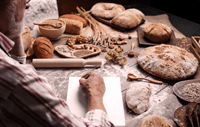
Bread is one of the oldest human-made foods. In fact, while the baking of bread truly got underway around 10,000 years ago with the spread of agriculture, the oldest evidence of bread-making has been discovered in a 14,500-year-old site in Jordan.
Since then, bread in its countless forms, has become a staple throughout the Middle East, Central Asia, North Africa, Europe, Australia and the Americas. It can be made from wheat flour, spelt, kamut, rye, barley, corn, oats, millet and rice, to name a few.
In recent years, with the rise of gluten-intolerance, gluten-free breads made from almonds, rice and beans have grown in popularity.
And while bread has been a staple of the Western diet for millennia, in recent years, the popularity of mass-market and bakery-made bread has resulted in most of us losing our cultural knowledge of how to make it.
There is no shortage of bread recipes online – you can find some beginner ones here – but here are a few tips to remember once you get started, courtesy of bread baking maven Uri Scheft:
1. Start simple: Bread’s ingredients are usually pretty simple – flour, yeast, water and salt – but putting them altogether isn’t always. Scheft suggests starting with basic breads that are easier to make, like challah or focaccia.
2. It’s all about the yeast: Dry yeast is readily available and will do in most cases but live wet yeast will make your bread taste and feel better.
3. You need to knead: Kneading your dough is like meditating, Scheft said – when you’re doing it, give it your all. No answering the phone, No checking Facebook. Get into the zone.
4. Don’t trust your oven: Bread baking can be a delicate process. While a lasagna may survive your oven’s uneven temperatures, your bread might not. You’ll need to watch your bread like a hawk, rotating it, taking it out early, leaving it in longer.
Have you started baking bread? Share your experiences now in the Shop Talk blog community forum.

Did you know: Take notes!
Your first couple of attempts may not be as successful as you hope but write everything down so you can figure out what might need to change next time.
